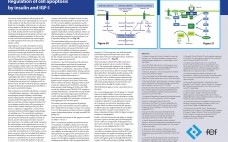An early BPI Lab article addressed the power of liquid chromatographic separations for biopharmaceutical laboratory use (1). Such techniques separate biomolecules based on a number of different properties: size, solubility, hydrophobicity/-philicity, binding affinity. The next most powerful means of separation — and thus high-resolution identification — of nucleic acids and proteins/peptides is based primarily on electrostatic properties: electrophoresis. Although it doesn’t really work in a process or preparative setting, it is a fundamental technique in modern biopharmaceutical laboratories, where it…
Upstream Processing
Design of Experiments for Fed-Batch Process Development in Shaken Cultures
When designing a recombinant protein production process, a high number of parallel cultivations must be carried out. That task is typically performed using batch cultures in shake flasks or microwell plates, in which fermentation conditions are not monitored. To overcome that limitation, we combined the SensorDish Reader and Shake Flask Reader systems (from PreSens) with an enzymatic glucose delivery system (EnBase technology from BioSilta Oy) for Escherichia coli cultivations. Our objective was to determine whether SensorDish reader cultures would yield…
Optimizing for the Future
The 2013 biennial meeting of the European Society for Animal Cell Technology (ESACT) was in Lille, France this past June. While there, BPI editorial advisor Miriam Monge (vice president of Biopharm Services Ltd.) interviewed ESACT executive committee member Hitto Kaufmann, PhD (vice president of biopharmaceutical process sciences for Boehringer Ingelheim). They talked about some scientific developments being discussed at this year’s ESACT conference as well as Boehringer Ingelheim’s recent announcement about setting up in China and Kaufmann’s own thoughts on…
Quality Risk Assessment and Management Strategies for Biopharmaceutical Companies
You’ve probably been hearing a lot about risk assessment in recent months. Indeed, some 15 times more articles have been printed referencing the concept over the past year relative to a 12-month period just three years ago. That truly represents a geometric progression. Unfortunately, very few authors have been able to disambiguate the different methods or provide insight into this time-tested, multiple-industry philosophy that at its core uses good science to make better decisions. When we undertake the challenge to…
Enabling Technologies
We hear a great deal lately about the maturation of the biopharmaceutical industry — and much advancement over the past decade or so has been in business models, financing, and product pipelines. Meanwhile, regulators around the world have become more well versed in the subject matter and have adjusted their approaches to and expectations from the industry. However, the practical side of developing, characterizing, and manufacturing biotherapeutic products cannot be overlooked — nor its importance overstated. Many technological…
Cost-Effectiveness and Robustness Evaluation for Biomanufacturing
As the biotech sector has matured, it has come under increasing economic and regulatory pressures for continuous improvement in both drug development and manufacturing. As a result, assessing the value potential of alternative strategies has become critical to decision-making in areas such as bioprocess and facility design, capacity sourcing, and portfolio selection. Related decisions typically involve large cash expenditures and thus have a direct bearing on the feasibility of business units and whole companies. Figure 1: () Making such decisions…
A Global Joint Venture Strategy for Biosimilars Development
In April 2013, biopharmaceutical company Pfenex (San Diego, CA) announced a joint venture with biologics manufacturer Stelis Biopharma, Inc. (“Stelis”), earlier known as Agila Biotech, (a wholly owned subsidiary of Strides Arcolab Limited (Bangalore, India) for the commercial development of six biosimilars. The companies will also leverage technology and global development expertise from GE Healthcare Life Sciences (Uppsala, Sweden) and Bio-XCell Malaysia (Nusajaya, Malaysia). Such international, multicompany collaboration strategies have become a growing trend in the highly competitive biosimilars industry.…
Regulation of cell apoptosis by insulin and IGF-I
An increase in the number of cells growing in cell culture is the result of two opposing effects: an increase in the number of cells that traverse the cell cycle and divide into two daughter cells (mitosis), or a decrease in the number of cells that die according to different modalities, the most prominent one being apoptosis (1), or both. Insulin and IGF-I are both capable of facilitating cell progression through the cell cycle, and of inhibiting apoptotic mechanisms. In…
Robots in the Laboratory
Whether cell-based or molecular biology focused, most assays performed in biopharmaceutical laboratories involve liquid solutions. Increasingly, automated liquid handlers (laboratory robotics) are demonstrating utility in these labs, especially for high-throughput screening and optimization of cell culture media, chromatography conditions, formulations, and so on. Some experts say that screening 100,000 samples/day will soon become routine. But the robots haven’t condemned all manual pipettes to the trash heap — far from it. With multichannel and electronic pipettes improving throughput and reproducibility of…
Impact of Process Interruption on Virus Retention of Small-Virus Filters
Manufacturers of biopharmaceuticals using mammalian cell culture must have processes in place to minimize the likelihood of virus contamination of their products. Regulatory agencies provide guidelines for testing strategies and best practices to assure raw-material safety and control of the manufacturing process. Safety assurance relies on an interdependent matrix of managed risks, including characterization and control of raw materials, extensive testing of process intermediates, and demonstration of the virus removal capabilities of purification unit operations Figure 1: () A dedicated…

